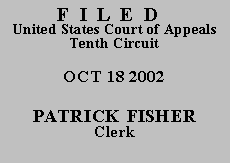

| CHARLES CHAPMAN THAMER II,
v.
DON BROWN, County Attorney, Utah
State Correctional System |
D.C. No. 2:01-CV-315-B (D. Utah) |
Before KELLY, McKAY, and MURPHY, Circuit Judges.
Pro se petitioner, Charles Chapman Thamer II, seeks a certificate of appealability ("COA") so he can appeal the district court's dismissal of his 28 U.S.C. § 2254 habeas petition. See 28 U.S.C. § 2253(c)(1)(A) (providing that no appeal may be taken from a final order disposing of a § 2254 petition unless the petitioner first obtains a COA). The district court dismissed Thamer's petition as untimely under the Antiterrorism and Effective Death Penalty Act of 1996.
A review of the appellate record and circuit case law reveals that this is Thamer's second petition for relief under 28 U.S.C. § 2254. On August 30, 1996, this court denied Thamer a COA and dismissed his appeal from a district court order denying his first habeas petition.(1) See Thamer v. Graf, No. 95-4192, 1996 WL 494308, at *1 (10th Cir. 1996) (unpublished disposition). Consequently, the § 2254 petition Thamer filed with the distict court on May 1, 2001 was a second or successive petition for relief pursuant to § 2254. Successive habeas petitions cannot be filed in district court until the petitioner "move[s] in the appropriate court of appeals for an order authorizing the district court to consider the application." 28 U.S.C. § 2244(b)(3)(A). Thamer, however, filed the instant petition in the district court without first requesting permission from this court.(2) Consequently, the district court lacked jurisdiction over Thamer's § 2254 petition.
Because we conclude that the instant § 2254 petition is successive, we construe Thamer's application for a COA and appellate brief as a request for authorization to file a second or successive habeas petition. See Pease v. Klinger, 115 F.3d 763, 764 (10th Cir. 1997). Our review of that implied application leads to the conclusion that Thamer has failed to make the prima facie showing necessary for filing a second or successive § 2254 petition. Even if we assume that Thamer's claims were not presented in his prior habeas petition, those claims do not involve either newly discovered evidence or a previously unavailable, new rule of constitutional law made retroactive to cases on collateral review by the Supreme Court. See 28 U.S.C. § 2244(b)(2).
Accordingly, the district court's order dated April 15, 2002 denying Thamer's unauthorized § 2254 petition is vacated and Thamer's implied application for leave to file a second or successive § 2254 petition is denied. Thamer is reminded that this court's denial of authorization to file a successive habeas petition cannot be subject to a petition for rehearing or a petition for a writ of certiorari. See 28 U.S.C. § 2244(b)(3)(E). All other outstanding motions are denied.
ENTERED FOR THE COURT
Michael R. Murphy
Circuit Judge
*. This order and judgment is not binding precedent, except under the doctrines of law of the case, res judicata and collateral estoppel. The court generally disfavors the citation of orders and judgments; nevertheless, an order and judgment may be cited under the terms and conditions of 10th Cir. R. 36.3.
1.Thamer indicates in his § 2254 petition that he was convicted in 1986 and is serving a life sentence.
2.When the § 2254 petition was filed without the required appellate court authorization, it should have been transferred to this court. See Coleman v. United States, 106 F.3d 339, 341 (10th Cir. 1997) ("[W]hen a second or successive petition for habeas corpus relief under § 2254 . . . is filed in the district court without the required authorization by this court, the district court should transfer the petition or motion to this court in the interest of justice pursuant to [28 U.S.C.] § 1631.").